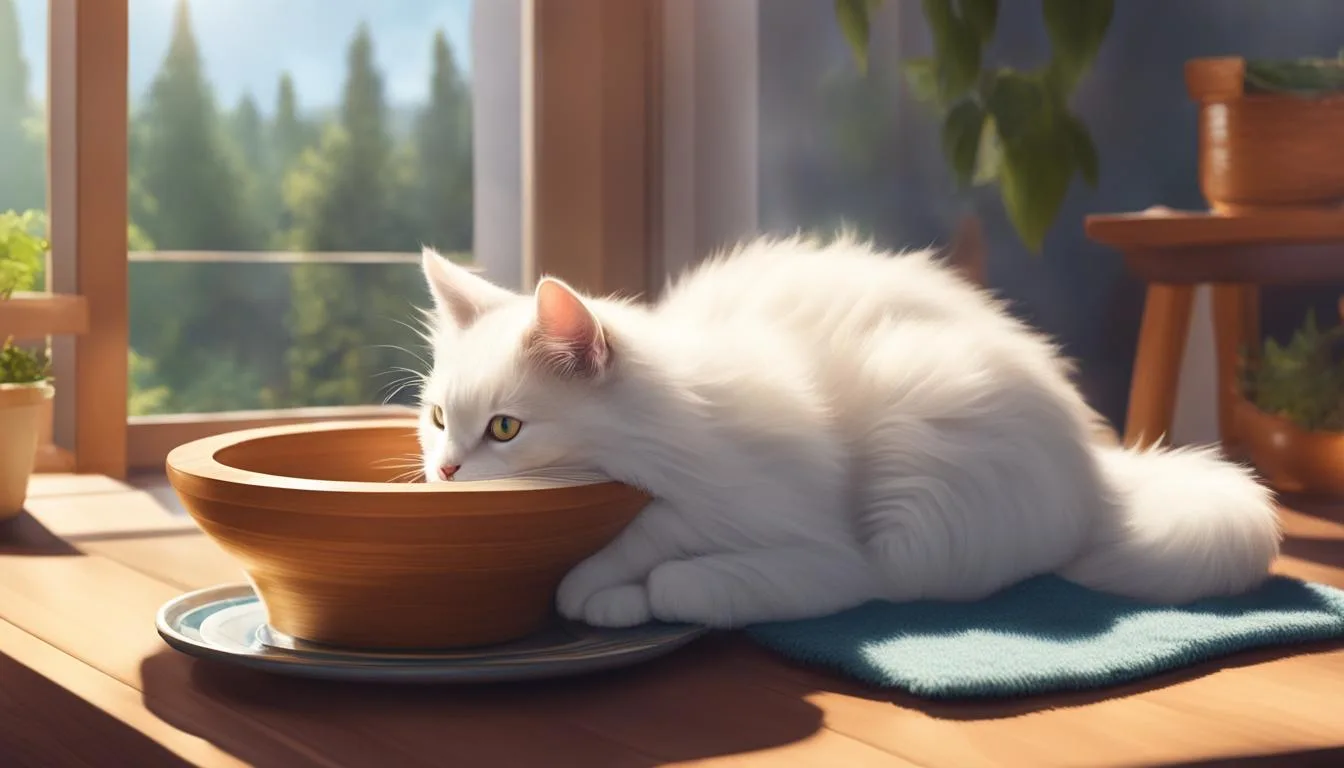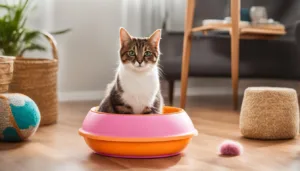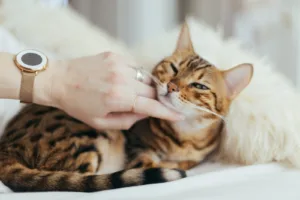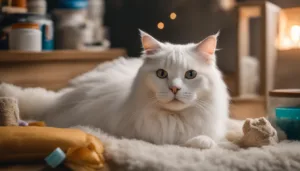Welcome to our comprehensive guide on cat care at home! If you’re a proud cat owner looking to provide the best care for your furry friend, you’ve come to the right place. In this guide, we’ll share invaluable tips and tricks to help you create a safe and nurturing environment, provide a nutritious diet, maintain your cat’s health, and cater to their emotional well-being. Whether you’re a new cat owner or a seasoned feline enthusiast, this guide will equip you with the knowledge and insights to ensure your cat leads a happy and fulfilled life.
As responsible cat owners, it’s essential to understand the specific needs of our feline companions and provide the care they require. From understanding their behaviors and communication to ensuring proper grooming and hygiene, we’ll cover it all. Let’s dive in and discover how to become a proficient cat caregiver!
Key Takeaways:
- Creating a safe environment is crucial for your cat’s well-being.
- A balanced and nutritious diet is essential for your cat’s health.
- Regular veterinary care and vaccinations are necessary to maintain your cat’s health.
- Mental stimulation and playtime are vital for your cat’s emotional well-being.
- Proper grooming and hygiene practices contribute to your cat’s overall health.
Understanding Your Cat’s Needs
Your cat’s behavior can sometimes seem mysterious, but by understanding their natural instincts and communication style, you can better meet their needs and ensure a harmonious home environment. Cats are fascinating creatures with unique personalities, and this section will delve into some key aspects of their behavior.
Cat Behaviors and Communication
Cats have a wide range of behaviors that serve various purposes. For example, scratching furniture may seem destructive, but it’s a natural way for cats to mark their territory and keep their claws in good condition. Understanding these behaviors can help you redirect them to more appropriate outlets.
“Cats are mysterious beings, known for their subtle communication cues,” says Dr. Jane Thompson, feline behavior specialist. “By paying attention to their body language, vocalizations, and facial expressions, you can decipher their messages and respond accordingly.”
“When a cat’s tail is upright and the fur is relaxed, it’s a sign of contentment,” Dr. Thompson explains. “On the other hand, a puffed-up tail indicates fear or aggression, and flattened ears may signal discomfort or aggression.”
Cat Socialization and Mental Stimulation
While cats are often seen as independent animals, they are social creatures that thrive on positive interactions. Proper socialization from an early age is crucial for their emotional well-being. It helps them feel comfortable around people and other animals, reducing the likelihood of behavior issues.
Cats also need mental stimulation to prevent boredom and destructive behavior. Providing interactive toys, puzzle feeders, and scratching posts can keep them mentally engaged and prevent stress-related problems. Dr. Thompson recommends “Rotating their toys to maintain novelty and using treat-dispensing toys to encourage problem-solving.”
Understanding your cat’s needs is the first step in creating a fulfilling and harmonious relationship. By observing their behaviors, decoding their communication cues, and providing socialization and mental stimulation, you can ensure your furry friend leads a happy and enriched life.
Creating a Safe and Enriching Environment
When it comes to cat care at home, creating a safe and enriching environment is essential for your furry friend’s well-being. Cat-proofing your home is the first step to ensure their safety. Remove any toxic plants, secure electrical cords, and store cleaning products out of reach. Additionally, provide vertical spaces for your cat to climb and explore. Cats love high perches, and these elevated areas not only provide exercise but also promote a sense of security and territory.
Interactive toys are another crucial aspect of creating an enriching environment for your cat. These toys stimulate their natural hunting instinct and keep them mentally engaged and physically active. From feather wands to puzzle toys and treat-dispensing balls, there are numerous options to choose from. Rotate the toys regularly to keep your cat’s interest piqued and prevent boredom.
“A safe and enriching environment is vital for your cat’s overall well-being. Providing vertical spaces and interactive toys are key to keeping them happy, stimulated, and physically active.” – Dr. Emily Johnson, Feline Behavior Expert
In addition to cat-proofing and interactive toys, consider creating dedicated play areas for your cat. Clear a space in your home where they can freely play and explore. Use cat tunnels, scratching posts, and hiding spots to enhance the play area. This designated space will not only provide mental stimulation but also help redirect their energy toward appropriate outlets.
| Benefits of Vertical Spaces | Benefits of Interactive Toys |
|---|---|
|
|
Remember, a safe and enriching environment is crucial for your cat’s overall well-being. Cat-proof your home, provide vertical spaces for climbing, and incorporate interactive toys to keep them mentally engaged and physically active. By creating a stimulating environment, you’re ensuring that your feline companion leads a fulfilling and happy life.
Providing a Nutritious Diet
When it comes to cat care, providing a nutritious diet is of utmost importance. A balanced and wholesome diet plays a vital role in your cat’s overall health and well-being. But with so many options available, it’s important to understand what your cat needs and how to choose the right food.
One of the key decisions you’ll face is whether to feed your cat wet or dry food. Both options have their advantages, so let’s take a closer look at the differences. Wet cat food, also known as canned food, is made with higher moisture content, which helps keep your cat hydrated and promotes urinary tract health. It is also more palatable for cats, making it a great choice for picky eaters or cats with dental issues. On the other hand, dry cat food, also known as kibble, is convenient, economical, and helps maintain dental health by reducing plaque and tartar buildup.
When selecting cat food, always check the label for the Association of American Feed Control Officials (AAFCO) statement. This statement ensures that the food meets the minimum nutritional requirements for cats. Look for high-quality protein sources as the main ingredient, such as chicken or fish. Avoid foods that contain fillers, artificial colors, and preservatives. It’s also important to consider your cat’s age, size, and specific dietary needs, such as weight management or food allergies.
| Wet Cat Food | Dry Cat Food |
|---|---|
| Higher moisture content | Convenient and economical |
| Palatable for picky eaters | Reduces plaque and tartar buildup |
| Helps promote urinary tract health | Longer shelf life |
Remember to transition your cat’s diet slowly, especially when switching between wet and dry food or introducing a new brand. Sudden changes can cause digestive upset. Monitor your cat’s weight and adjust the portion sizes accordingly to prevent obesity or malnutrition. And always provide fresh water alongside their meals to keep them hydrated.
In summary, a nutritious diet is the cornerstone of cat care. Choose a high-quality cat food that meets your cat’s nutritional needs and consider their preferences, age, and specific dietary requirements. Whether you opt for wet or dry food, the key is to provide a balanced diet that promotes good health and ensures your cat thrives.

Maintaining Your Cat’s Health
Ensuring the well-being of your furry friend goes beyond providing a loving home and nutritious food. Regular veterinary care is crucial for maintaining your cat’s health and preventing potential issues. From vaccinations to addressing common health concerns, here’s what you need to know to keep your cat in optimal condition.
Regular Veterinary Care
Scheduling regular check-ups with a trusted veterinarian is essential for your cat’s overall health. These visits allow your vet to monitor your cat’s weight, dental health, and overall well-being. During these appointments, your vet can also administer necessary vaccinations to protect against common feline diseases and parasites.

Common Health Issues in Cats
Cats can be prone to certain health issues, including dental problems, urinary tract infections, and obesity. It is essential to be aware of the signs of these conditions to seek prompt veterinary care. Regular grooming and monitoring your cat’s weight can help prevent obesity, while providing a balanced diet and dental hygiene can reduce the risk of dental problems.
Vaccinations for Cats
Vaccinations play a vital role in protecting your cat from contagious diseases. Common vaccinations for cats include those for rabies, feline viral rhinotracheitis, calicivirus, and panleukopenia. Your veterinarian can advise you on the appropriate vaccination schedule for your cat based on their age, lifestyle, and risk factors.
Summary
Maintaining your cat’s health requires regular veterinary care, including vaccinations and preventive measures. By being proactive in addressing common health issues and providing the necessary care, you can help ensure that your feline companion leads a happy and healthy life.
Nurturing Your Cat’s Emotional Well-being
Cats are not just pets; they are beloved companions who also have emotional needs. Understanding and addressing these needs is crucial to ensuring your cat’s overall well-being and happiness. By providing mental stimulation, reducing stress, and fostering a strong bond, you can nurture your cat’s emotional well-being and create a harmonious home environment.
One essential aspect of nurturing your cat’s emotional well-being is through playtime. Engaging in regular play sessions with interactive toys is not only physically beneficial but also mentally stimulating for your cat. Interactive toys, such as wand toys, puzzle toys, and treat-dispensing toys, provide opportunities for your cat to use their natural instincts and engage in interactive play. This helps to alleviate boredom, reduce stress, and promote a healthy and happy cat.
In addition to playtime, it is important to create a stress-free environment for your feline friend. Cats are sensitive creatures and can easily become stressed by changes in their surroundings or routine. Providing a safe and secure space, free from loud noises and potential stressors, helps to promote a sense of calm. Creating cozy hideaways, offering vertical spaces for climbing and observing, and using pheromone diffusers can also help reduce stress and anxiety in cats.
Positive reinforcement is another key element in nurturing your cat’s emotional well-being. By rewarding good behavior, such as using the litter box or scratching posts, with praise and treats, you can strengthen the bond between you and your cat. Avoid punishment or negative reinforcement, as this can lead to fear and stress.

Table: Benefits of Interactive Toys for Cats
| Benefits | Description |
|---|---|
| Physical exercise | Interactive toys encourage cats to be physically active, helping to maintain a healthy weight and prevent obesity. |
| Mental stimulation | Interactive toys provide mental stimulation by engaging your cat’s natural hunting instincts, reducing boredom, and preventing destructive behavior. |
| Bonding time | Engaging in interactive play with your cat strengthens the bond between you and promotes a sense of trust and companionship. |
| Stress reduction | Interactive toys help alleviate stress and anxiety in cats, providing an outlet for pent-up energy and promoting relaxation. |
Summary
Nurturing your cat’s emotional well-being is essential for their overall health and happiness. By providing regular playtime with interactive toys, creating a stress-free environment, and using positive reinforcement, you can ensure that your cat leads a fulfilled and contented life. Remember to observe your cat’s behavior and adjust your approach to meet their individual needs.
Grooming and Hygiene Tips
Grooming plays a crucial role in maintaining your cat’s overall health and well-being. Regular grooming sessions not only keep their coat clean and shiny but also help prevent common issues such as matting, hairballs, and skin infections. Here are some essential grooming and hygiene tips to keep your feline friend looking and feeling their best.
Regular Brushing
Brushing your cat’s fur is essential to remove loose hair, prevent matting, and distribute natural oils throughout their coat. The frequency of brushing depends on your cat’s breed and coat length. Long-haired cats may require daily brushing, while short-haired cats may only need to be brushed once or twice a week. Use a brush or comb specifically designed for cats, and be gentle to avoid discomfort. If your cat is resistant to brushing, start with short sessions and reward them with treats to create a positive association.
Nail Trimming
Trimming your cat’s nails is important to prevent them from becoming too long or sharp. Invest in a pair of cat nail clippers or use human nail clippers with a straight edge. Gradually introduce your cat to nail trimming by gently handling their paws and rewarding them with treats. Be cautious not to cut into the quick, which is the pink part of the nail that contains blood vessels and nerves. If you’re unsure or uncomfortable with trimming your cat’s nails, consult a professional groomer or your veterinarian.
Dental Care
Just like humans, cats also require dental care to maintain good oral health and prevent dental diseases. Regular brushing with a cat-specific toothbrush and toothpaste can help remove plaque and prevent tartar buildup. Start by getting your cat accustomed to the taste of toothpaste and gradually introduce toothbrushing. If your cat is resistant to brushing, there are dental wipes and dental treats available that can help promote dental hygiene. It’s also important to schedule regular dental check-ups with your veterinarian to ensure your cat’s teeth and gums are in good condition.
| Grooming and Hygiene Tips | Key Points |
|---|---|
| Regular Brushing | – Removes loose hair and prevents matting – Distributes natural oils for a healthy coat |
| Nail Trimming | – Prevents nails from becoming too long or sharp – Should be done with caution to avoid cutting the quick |
| Dental Care | – Regular brushing prevents plaque and tartar buildup – Dental check-ups are important for overall oral health |
Remember, grooming sessions can also be an opportunity to bond with your cat. Approach grooming with patience and positive reinforcement to ensure a stress-free experience for both you and your furry companion. If you have any concerns or difficulties with grooming, don’t hesitate to seek advice from a professional groomer or your veterinarian.

Ensuring Proper Litter Box Use
One of the essential aspects of cat care at home is ensuring that your furry friend has a clean and suitable litter box. Cats are naturally clean animals, and providing them with a proper place to eliminate is crucial for their physical and mental well-being. In this section, we will explore the key factors to consider when it comes to litter box training, troubleshooting common problems, and maintaining a hygienic environment for your cat.
When introducing your cat to a litter box, it is important to choose the right type of litter. Most cats prefer unscented, clumping litter, as it closely resembles the natural texture of sand or soil. Fill the litter box with enough litter to allow your cat to dig and bury their waste comfortably. Place the litter box in a quiet and easily accessible area, away from their food and water bowls, to ensure their privacy and convenience.
Table:
| Common Litter Box Problems | Troubleshooting Tips |
|---|---|
| 1. Inappropriate elimination outside the box | – Ensure the litter box is cleaned regularly |
| 2. Avoiding the litter box altogether | – Try different types of litter |
| 3. Marking territory with urine | – Provide multiple litter boxes in different areas of your home |
Regular maintenance of the litter box is essential to keep your cat satisfied and prevent litter box aversion. Scoop the litter box daily to remove waste and clumps, and change the entire litter every 1-2 weeks. This will help maintain a clean and odor-free environment for your cat. Additionally, it’s important to note that each cat may have their own preferences and behaviors when it comes to litter box use. Observing their habits and addressing any issues promptly will ensure a positive litter box experience for your furry companion.
Tips for Successful Litter Box Training
- Choose a quiet and accessible location for the litter box.
- Use unscented, clumping litter that resembles natural soil or sand.
- Place multiple litter boxes in different areas of your home, especially for households with multiple cats.
- Provide regular litter box maintenance, including daily scooping and litter changes every 1-2 weeks.
In conclusion, ensuring proper litter box use is crucial for your cat’s well-being and the overall harmony of your home. By following the tips and troubleshooting methods provided in this section, you can establish a positive litter box routine that will keep your cat happy and your home clean.
Playtime and Interactive Toys
Playtime is an essential part of your cat’s daily routine. Engaging in play not only provides mental stimulation and physical exercise but also strengthens the bond between you and your furry companion. Interactive toys are a fantastic way to keep your cat entertained and fulfill their natural hunting instincts. Let’s explore the different types of cat toys that are guaranteed to bring joy to your feline friend.
Toys for Active Play
Active play toys are designed to get your cat moving and running, simulating the thrill of a hunting experience. Wand toys with feathers or dangling objects are excellent choices, as they allow you to interact with your cat while triggering their predatory instincts. Additionally, laser pointers can provide endless entertainment, but remember to avoid shining them directly into your cat’s eyes.
Puzzle Toys for Mental Stimulation
If your cat enjoys a challenge, puzzle toys are a great way to provide mental stimulation and prevent boredom. These toys often hide treats or require your cat to solve a puzzle to access their food. Puzzle feeders or treat-dispensing toys keep your cat engaged for longer periods, providing both physical and mental exercise.
Catnip Toys for Fun and Relaxation
Catnip toys are beloved by many cats and can provide hours of entertainment. Catnip, a natural herb, has a stimulating effect on most cats, making them more active and playful. Look for toys filled with dried catnip or opt for catnip-infused plush toys. However, it’s important to note that not all cats are affected by catnip, so observe your cat’s reaction before incorporating it into their playtime.
| Type of Toy | Description |
|---|---|
| Wand Toys | Feather or dangling objects attached to a wand for interactive play. |
| Laser Pointers | A handheld device that emits a laser light for your cat to chase. |
| Puzzle Toys | Toys that require problem-solving skills to access treats or food. |
| Catnip Toys | Plush toys filled with dried catnip or infused with catnip extracts. |
“Playtime with interactive toys is not only fun for your cat but also helps them maintain a healthy weight, reduces stress, and provides mental stimulation.”
Remember to rotate your cat’s toys regularly to keep their interest levels high. Introducing new toys and hiding them in different locations will provide novelty and mimic the hunting experience. Always supervise playtime and ensure that the toys you choose are safe and free from small or easily swallowable parts.
By incorporating playtime and interactive toys into your cat’s routine, you are providing them with the physical and mental stimulation they need for a happy and fulfilled life. Remember, each cat has unique preferences, so try different toy types to find what your furry friend enjoys the most. Now, go ahead and create a playful environment that will bring endless joy to your feline companion!
Conclusion
In conclusion, this ultimate guide provides essential tips and advice for cat care at home. By understanding your cat’s needs, creating a safe and enriching environment, providing a nutritious diet, maintaining their health, and nurturing their emotional well-being, you can ensure that your furry friend leads a happy and fulfilled life.
Remember to consult with a veterinarian for personalized advice and continue learning about cat care to stay informed about the latest insights and best practices. It is important to stay proactive in monitoring your cat’s health, addressing any concerns promptly, and providing the necessary attention and care they deserve.
Whether it’s through playtime, grooming, or maintaining a clean litter box, every aspect of cat care contributes to their overall well-being. By incorporating these cat care takeaways into your daily routine, you can create a loving and supportive environment that allows your cat to thrive.
FAQ
What are some common cat behaviors?
Common cat behaviors include scratching, grooming, hunting, and marking territory.
How do cats communicate?
Cats communicate through body language, vocalizations, and scent marking.
Why is socialization important for cats?
Socialization helps cats develop confidence, reduces fear and aggression, and promotes positive interactions with humans and other animals.
How can I provide mental stimulation for my cat?
You can provide mental stimulation for your cat through interactive toys, puzzle feeders, and regular play sessions.
How can I cat-proof my home?
Cat-proofing your home involves securing hazardous items, covering electrical cords, and blocking off access to areas that could be dangerous for your cat.
What are vertical spaces for cats?
Vertical spaces for cats include cat trees, shelves, and perches that allow cats to climb, explore, and observe their surroundings.
What types of toys are best for cats?
Cats enjoy interactive toys such as wand toys, puzzle toys, and treat-dispensing toys that stimulate their natural hunting instincts.
What should I look for when choosing cat food?
Look for cat food that is nutritionally balanced, made with high-quality ingredients, and suitable for your cat’s age and health needs.
How often should I take my cat to the veterinarian?
Regular veterinary check-ups are recommended at least once a year for adult cats and more frequently for kittens, senior cats, or cats with health conditions.
What are some common health issues in cats?
Common health issues in cats include dental problems, obesity, urinary tract infections, and respiratory infections.
How can I reduce stress in my cat?
You can reduce stress in your cat by providing a consistent routine, creating a calm environment, and using pheromone products or calming supplements if needed.
How often should I groom my cat?
The frequency of grooming depends on your cat’s coat type, but most cats benefit from regular brushing, nail trimming, and occasional dental care.
How can I handle a resistant cat during grooming?
Gradual desensitization, positive reinforcement, and using grooming tools that your cat is comfortable with can help make grooming sessions less stressful for resistant cats.
What type of litter is best for cats?
Cats have preferences when it comes to litter, but most prefer unscented, clumping litter that provides comfortable footing and easy scooping.
How can I encourage proper litter box use?
Place the litter box in a quiet, accessible location, keep it clean, and provide multiple litter boxes for multi-cat households.
What types of toys are recommended for cats?
Recommended toys for cats include wand toys, laser pointers, puzzle toys, and interactive treat-dispensing toys.




